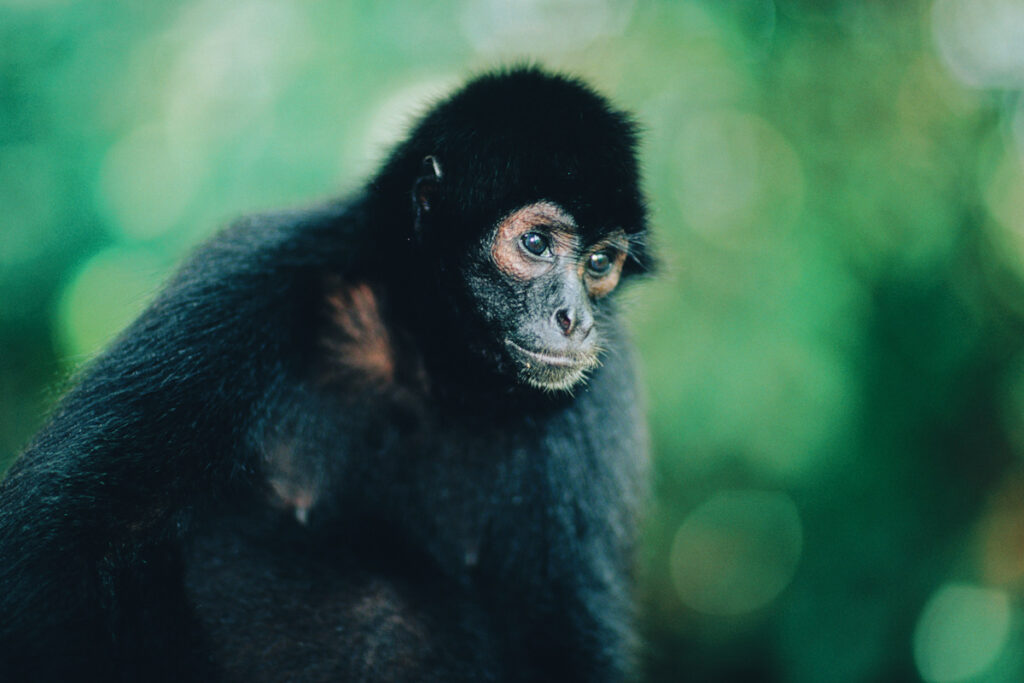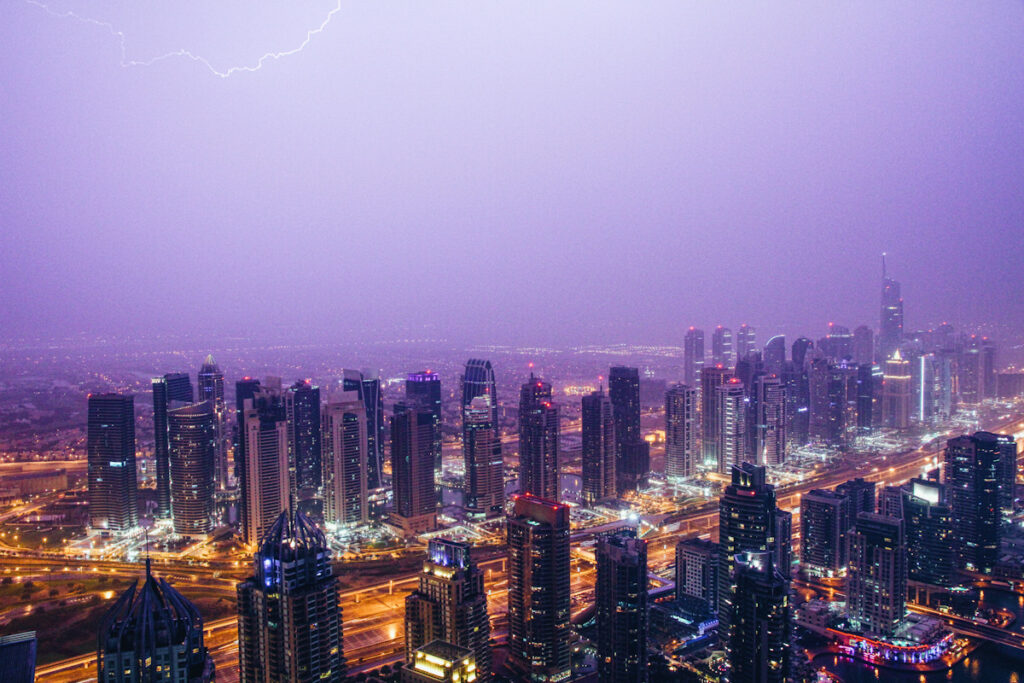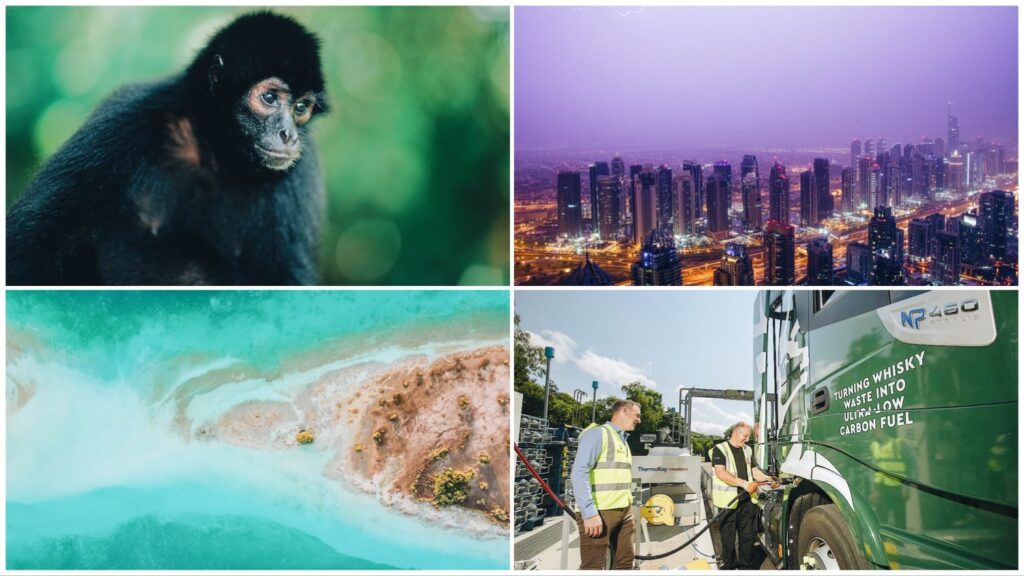In a huge win for campaigners and captive animals, the last circus monkey in Peru just returned to the wild. After more than three years of rehabilitation at a reserve near Puerto Maldonado, Maruja the spider monkey and her adoptive family have been released into their natural habitat. Meanwhile, Scottish whisky deliveries are being powered by one brand’s distillery waste, underwater reefs are alive (and storing carbon), and technology has created fake rain to help keep Dubai cool—and powered UK homes with renewables. Here’s this week’s positive environmental news.

The last circus monkey in Peru just went home
The good news: Maruja the monkey has finally gone home. She was initially rescued by Animal Defenders International (ADI) back in 2017 after experiencing significant cruelty at the hands of an illegal circus. (Peru’s circus ban was previously enforced between 2014 and 2016, leading to the seizure and relocation of hundreds of animals.)
Maruja’s release follows several years of rehabilitation at the Taricaya Ecological Reserve, during which she fostered orphaned baby monkeys—an act of nurture that also helped her regain some of the instincts and behaviors lost in captivity. Finally, at the end of last month, ADI was able to safely return both Maruja and her adoptive family to their home in the forest.
The impact: According to the ADI, the Peruvian or Black-Faced spider monkey can live up to 25 years in the wild, and they maintain tight-knit family units within complex societies. They are communicative and rank third overall in terms of intelligence in non-human primates. As shown in its impact on Maruja, captivity and cruelty take a significant toll on individual animal’s lives. But her successful release also shows that rehabilitation and re-release can be possible.
Did you know: Spider monkeys are so-named because they look like arachnids when they hang from branches by their prehensile tails. Peruvian monkeys, such as Maruja, remained on the IUCN’s endangered list, though their status was downgraded to “least concern” in 2003. Despite having only vestigial thumbs, the animals can move through the tree canopies with ease using their nimble tails. This, along with spider monkey’s feeding habits, are conducive to seed dispersal—making them absolutely essential for continued forest health.
How you can help: You can donate to ADI or find out more about volunteering here. Spider monkeys are primarily threatened by hunting and human-caused habitat loss, but supporting reforestation in Peru and South America helps protect and replace important ecosystems such as Maruja’s home.

Glenfiddich just became the first-ever spirits producer to run its fleet on waste
The good news: Glenfiddich, the producers of the world’s best-selling single malt whiskey, will use distillery waste-derived low-carbon biogas to power its delivery fleet. This forms a key part of its new closed-loop transport initiative, and each vehicle could displace up to 250 tonnes of CO2 per year compared to traditional diesel trucks. It will also find a sustainable use for the spent grains that Glenfiddich previously sold as high-protein cattle feed.
The impact: According to the brand, the 250 tonnes of displaced CO2 per truck is approximately equal to planting 4,000 trees or removing fossil fuel-based gas from 112 households. Glenfiddich’s trucks are used at every stage of production and delivery, and the company says it plans to expand its unique circular process across its entire supply chain, even sharing the technology with other producers within the industry to help them achieve similar targets.
Did you know: Glenfiddich is the first-ever distillery to process all of its waste residues on-site. Its biogas emits 95 percent less CO2 than comparable fossil fuels and reduces other harmful emissions by up to 99 percent. The “green” gas is produced via anaerobic digestion, or fermentation, and proponents of this method suggest that its zero-emissions process makes it an extremely viable (and relatively accessible) alternative to both traditional fossil fuels and natural gas.
How you can help: You can learn more about closed-loop production and the circular economy here, and learn more about Glenfiddich’s sustainability journey here. The Whisky Wash delves into the sustainability of Scotch whiskey in detail here, and you can read more about the industry’s broader sustainability strategies here.

Drones could help Dubai cool down with… Fake rain?
The good news: Scientists at the UK’s University of Reading could help provide the United Arab Emirates (UAE) with some relief from soaring temperatures using ‘fake’ rain. Four drones, with a wingspan of approximately 6.5 feet each, can be used to stimulate clouds into producing rain. This Rain Enhancement Science project was funded by the UAE, which provided a $1.5 million research grant to the university back in 2017.
The impact: The creation of artificial or fake rain could mean relief for arid regions around the world, including Dubai. The city is extremely hot, particularly at this time of year, and temperatures can reach highs of around 122°F (50°C). The UAE, in general, experiences just a few days of rain (an average of four inches) per year. Climate change, a growing population, and a finite water supply are making Dubai’s dry desert conditions even more difficult to live with, and a practical solution to water shortages is a necessity moving forward.
Did you know: When the fine water in clouds condenses to form larger drops, they fall to earth as rain. The specialist drones use sensors to analyze each cloud in order to find the ideal combination of humidity and temperature, before using electricity to stimulate the condensation of water droplets—thereby ‘creating’ fake rain. Along with cloud seeding and other weather modification technology, the drones could help to end chronic droughts and manage heat in the future.
How you can help: Global warming is contributing to droughts and other extreme weather conditions around the world. By living as sustainably as possible, we can all minimize our contributions to climate change. Whether you live in a drought-affected area or not, reducing water waste places a huge strain on the planet’s finite resources. Friends of the Earth put together a handy guide here for cutting back. Avoiding companies and corporations who disregard the need for water conservation can also help, and you can learn more about fake rain and other weather modification technology here.

Three-billion-year-old microbial reefs are still alive (and storing carbon)
The good news: Mexico’s Lake Bacalar is home to a population of stromatolites (Greek for “layered rock”) that has been there for approximately 3.5 billion years. The almost fungal-looking microbial reefs are some of the earliest existing evidence for life on earth, and Lake Bacalar’s stromatolites are still alive and still recycling the air’s CO2 to preserve environmental health.
The impact: Much like their terrestrial counterparts, trees, stromatolites are alive, breathe, and play a crucial role in recycling atmospheric elements. The microbes that form each stromatolite take in carbon from the air above the water and sequester it within the lake floor. It’s also worth noting that they have done this for billions of years, playing a crucial role in the evolution of life on earth.
Did you know: By absorbing CO2 and emitting oxygen, these ancient structures helped to bring O2 levels up to the optimal 21 percent required for life as we know it. However, today living stromatolites can be found in just a few lagoons, lakes, and bays worldwide. They face dangers such as pollution and physical damage from tourism, industry, and animal agriculture.
How you can help: Practicing sustainable tourism (wherever you visit next) helps protect all life, including stromatolites. UNESCO provides a guide for those working in the tourism industry here, and Responsible Travel provides information for travelers here. Lake Bacalar, in particular, is threatened by unsustainable tourism, and conservation groups Agua Clara Bacalar and Laguna Bacalar are working locally to preserve the ecology of the unique ecosystem.

Britain was officially mostly powered by renewables in 2020
The good news: According to a recent UK government report, renewable energy outstripped fossil fuels for the first time ever last year. This also coincided with a coronavirus-caused drop in energy demand, falling to its lowest since the 1950s. Where fossil fuel generation provided 37.7 percent of the nation’s energy in 2020, renewables provided 43.1 percent.
The impact: Statistics aside, renewable energy is going to be instrumental in how the world tackles climate change, global inequality, and food production in the years to come. This report shows clearly that, despite the difficulties in moving away from fossil fuels, the UK—and countries around the world—are slowly but surely making positive changes.
Britain’s growing number of wind farms, in particular, are responsible for 2020’s momentous shift in power generation. Overall, fossil fuel generation has fallen 59 percent since 2010, while renewable generation has increased by 500 percent.
Did you know: While renewable energy can feel like an entirely modern premise, it can be traced back to hydropower water wheels from thousands of years ago. This technology developed into windmills over the next several hundred years, which were ultimately modernized in the 1500s in the Netherlands.
These iconic Dutch windmills directly influenced the modern wind turbines we see today. In the mid-1800s, French physicist Edmond Becquerel first observed the photovoltaic effect, a moment widely acknowledged as the birth of modern solar power (though we’ve come a long way since then).
How you can help: Switching to a sustainable energy supplier (or at least away from known greenwashers) can help mitigate your personal carbon footprint, and shows the industry that consumers want to prioritize more environmentally friendly options (and hopefully avoid the need for even more fake rain).
Many price comparison sites now offer a filter to help search for green companies, and Money Saving Expert offers a guide to installing and operating your own solar panels here. While organizations such as Friends of the Earth, Power For People, Solar Power Europe, Go Fossil Free, Environment America, and many more are all campaigning for renewable energy.
Looking for more positive news stories? Read the previous selection here.


